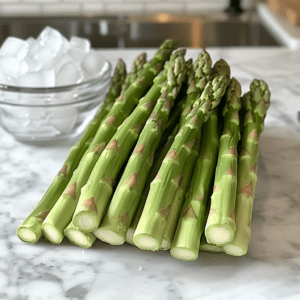Can you Freeze Asparagus ?
Freezing asparagus is a great way to preserve its freshness and enjoy this nutritious vegetable all year round. In this article, we’ll explore the simple steps you can take to freeze asparagus effectively, ensuring it retains its flavour, texture, and nutritional value.
Why Freeze Asparagus?
Asparagus is a versatile vegetable that’s not only delicious but also packed with health benefits. However, its peak season is quite short. Freezing asparagus allows you to extend its shelf life, making it possible to enjoy this spring vegetable even in the off-season.
The Freezing Process which answers your question of Can you freeze Asparagus ?
Step 1: Select Fresh Asparagus
Choose young, tender stalks with tight, compact tips. Freshness is key to ensuring your frozen asparagus tastes great when it’s time to use it.
Step 2: Clean and Trim
Wash the asparagus thoroughly under cold water to remove any dirt or debris. Trim the woody ends off the stalks, as these parts are tough and not pleasant to eat.
Step 3: Blanch the Asparagus
Blanching is a crucial step in the freezing process. It involves boiling the asparagus spears for a few minutes and then quickly transferring them to an ice-water bath to halt the cooking process. This step helps preserve the asparagus’s vibrant green color and crisp texture.
Step 4: Dry Thoroughly
After blanching, it’s important to dry the asparagus completely. Use paper towels or a clean kitchen towel to pat the spears dry. Any excess moisture can lead to ice crystals forming, which can affect the texture of the asparagus when thawed.
Step 5: Flash Freeze
Spread the asparagus spears out on a baking sheet, ensuring they’re not touching, and place them in the freezer. This is known as flash freezing and helps prevent the spears from sticking together in the freezer.
Step 6: Store Properly
Once the asparagus spears are frozen solid, transfer them to a freezer-safe bag or container. Remove as much air as possible before sealing to prevent freezer burn. Label the container with the date, so you know how long the asparagus has been stored.
Using Frozen Asparagus
When you’re ready to use your frozen asparagus, there’s no need to thaw it first. You can cook it directly from frozen, making it a convenient addition to stir-fries, soups, and other dishes.
So, can you freeze asparagus? Absolutely! By following these simple steps, you can preserve the freshness and nutritional value of asparagus and enjoy this delightful vegetable any time of the year.
Seasonality of Asparagus
Asparagus, a delectable vegetable cherished by many, exhibits a distinct seasonality that aficionados eagerly anticipate each year. Spring heralds the peak of asparagus season, with its tender spears bursting forth from the earth in a vibrant display of freshness and flavor. This seasonal delight is not just a culinary sensation but also a testament to nature’s bountiful offerings. The short-lived nature of the asparagus season adds to its allure, as devotees savor every fleeting moment of indulgence before the harvest draws to a close. From farm to table, the journey of asparagus embodies a celebration of the changing seasons and the exquisite flavors they bring. Embracing the seasonality of asparagus is not just a gastronomic choice but a transformative experience that connects us to the rhythms of nature and the joy of savoring what each season uniquely offers.
All About Asparagus: The Quintessential Versatile Vegetable
Asparagus, a perennial vegetable, becomes a staple in kitchens around the world due to its versatility. This exceptional veggie can be used in an array of culinary creations, including salads, stir-fries, and soups. It’s not just about its utility in cooking, but also the unique flavor and texture that asparagus brings to the table, making it a favored ingredient for many chefs and home cooks alike. This piece will delve into the manifold uses of asparagus in the culinary world.
Unveiling the Health Potential of Asparagus
Before jumping into the various scrumptious ways to incorporate asparagus into your meals, it’s integral to understand the health benefits that come along with it. Being nutrient-dense and low in calories, asparagus is brimming with essential vitamins and minerals. The vegetable is a potent source of dietary fiber, folate, and vitamins such as A, C, E, and K. Plus, it’s rich in chromium, a trace mineral that fortifies the function of insulin in transporting glucose from the bloodstream into cells.
- Anti-Inflammatory and Antioxidant Properties: Several studies propose that asparagus possesses anti-inflammatory and antioxidant properties. These attributes can help mitigate the risk of chronic ailments like heart disease and cancer.
- Natural Diuretic: Asparagus acts as a natural diuretic, which helps eliminate excess salt and fluid from the body. It’s an excellent option for those aiming to alleviate bloating or water retention.
Exploring the Culinary Domain of Asparagus
Asparagus can be prepared in numerous enjoyable ways, and here are some notable ones:
- Roasted Asparagus: The simplicity and deliciousness of roasted asparagus are unmatched. Dress the spears in olive oil, salt, and pepper before roasting them in a preheated oven. The roasting process accentuates the asparagus’s inherent sweetness, making it an ideal side dish complementing any meal.
- Asparagus Soup: A bowl of warm asparagus soup can provide comfort on a brisk day. Start with sautéing onions and garlic in butter, followed by adding chopped asparagus, vegetable broth, and a dash of cream. Blend the mixture until smooth and finish it off with a dollop of crème fraîche or a handful of fresh herbs to amplify the elegance.
- Asparagus Salad: Asparagus can bring a new dimension to salads with its fresh and crispy texture. Blanch the asparagus briefly in boiling water, then submerge it in ice water to preserve its vibrant green hue. Combine it with mixed greens, cherry tomatoes, feta cheese, and a lemon vinaigrette for a refreshing salad.
- Asparagus Stir-Fry: For an easy and healthful dish, consider an asparagus stir-fry. Sauté sliced asparagus with your preferred protein, like chicken or tofu, and add garlic, ginger, soy sauce, and a drizzle of rice vinegar. Serve this hearty stir-fry over steamed rice for a wholesome meal.
Embracing the Flavors of the Seasons: Asparagus Seasonality
Distinguished by its unique flavor and versatility in the kitchen, asparagus is a beloved vegetable that holds a prominent place in many dishes. When it comes to cooking, the understanding of asparagus seasonality can maximize the flavors of your meals. This comprehensive guide will delve into the different seasons of asparagus, provide detailed tips for selecting and storing this wonderful ingredient, and share some mouth-watering recipes to inspire your culinary journey.
The Seasonal Journey of Asparagus
Identified as a quintessential spring vegetable, asparagus flourishes during its peak season, running from March through June. This is the ideal time to savor fresh asparagus, brimming with the best quality and taste. Despite its seasonal nature, the progression of modern farming methods and global imports have ensured the availability of asparagus throughout the year.
- Spring: This is when asparagus truly shines. During spring, the spears of the vegetable radiate a vibrant green hue, signifying their tenderness and robust flavor.
- Summer: The quality of asparagus slightly dwindles in the summer. However, many grocery outlets and farmers’ markets continue to supply fresh asparagus.
- Fall: As the fall season commences, the availability of fresh asparagus begins to wane.
- Winter: While fresh asparagus is a rare sight during winter, imported varieties may still be found in certain stores.
A Guide to Selecting and Safely Storing Asparagus
When it comes to choosing asparagus, opt for spears that are firm and straight with tips that are tightly closed. It’s best to bypass spears that are wilted or emit a potent smell. The perfect asparagus has a vibrant green color, showing little to no signs of white or purple discoloration.
Storing asparagus requires some attention. Start by trimming the ends and standing the spears upright in a container filled with an inch of water. The tops should be covered with a plastic bag and refrigerated, where they can be stored for up to a week. For longer storage, you can blanch and freeze asparagus.
Do read our other recipes also by clicking below links:





